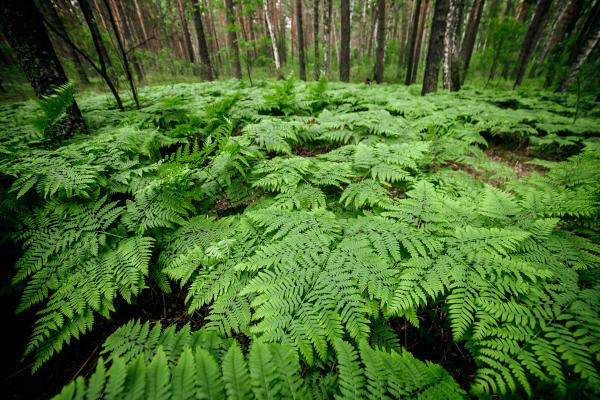Botany (from the greek botan, which means plant) is an area of Biology dedicated to the study of plants. Traditionally, other organisms are studied in Botany, such as seaweed, fungi and cyanobacteria. These organisms, however, are not treated like plants and are included only by tradition of being often considered part of the botany curriculum.
At plants they are multicellular living beings, eukaryotes and autotrophic (except parasitic plants) essential for humans and other organisms, presenting an economic as well as an ecological role. Didactically, plants are classified into four groups: bryophytes, pteridophytes, gymnosperms and angiosperms. In most plants, we find three basic plant organs: source, stem and leaves. seeds are present in gymnosperms and angiosperms, while flowers and fruits they are present only in angiosperms.
Read too: Botany Concepts — The Basic Definitions for Understanding the Field
Botany Study Areas
As said, Botany is a area of Biology dedicated to the study of plants
, but which also includes other living organisms that are traditionally studied by botanists, such as fungi and algae. Botany has a series of subdivisions, some of which are presented below.
Plant anatomy: area that turns to the structure of plants. In this field, it is studied, for example, how the plant tissue they are distributed in the plant's body and how their structure is related to the adaptations of plants to the environment in which they live.
Plant Physiology: subdivision of Botany that studies the functioning of plants. Processes like photosynthesis, nutrition, breathing and tropisms are studied in plant physiology.
Plant morphology: its object of study is morphology, that is, the shape and structure of plants. In this area, we study the sheet format, types of stemare you and roots, for example.
Taxonomy and plant systematics: subarea of Botany concerned with the identification and classification of plants.
Ethnobotany: studies the relationship between men and plants, concerned with understanding how certain plants are used by certain communities.
Plant ecology: as the name suggests, it is focused on the study of the interaction of plant organisms with each other and with the environment.
Paleobotany: Botany area concerned with the study of records of plant organisms that lived in the past. This study is important for us to understand, for example, the evolution of plants and what the planet was like thousands of years ago.
The importance of studying plants

THE Botany is an extremely important area., since plants are used in different ways by human beings and are fundamental for the maintenance of life as we know it today. When we talk about plants, we immediately remember that they are a source of food for us, human beings, and also for other animals, which often serve as food for us.
We must also not forget that they provide shelter for several species, help in the maintenance of the climate, ensure soil stabilization and that, through the photosynthesis process, are responsible for releasing oxygen, which we use in breathing. Economically, plants are important for providing wood, fibers for making clothes, raw material for the making paper and important components for the manufacture of cosmetics and medicines used in the treatment of various illnesses. Plants are also used for ornamentation, being used in gardens and parks.
When we study the plants, we can guarantee, for example, greater productivity of the plants used by the man, discover new beneficial compounds and understand how we can ensure the preservation of different species.
Read too:Areas of Study of Biology
Main parts of a plant
When we talk about plants, some parts should be highlighted, namely: root, stem, leaves, seeds, flowers and fruits. We will better understand the main features of each of these parts below.

Source: absent in bryophytes, the roots are important for guaranteeing the fixation of the plant in the substrate and allowing water absorption. Some roots also perform other functions, acting, for example, as reserve organs, such as beetroot and sweet potato.
Stalk: structures absent in bryophytes that have two main functions: support and conduction. The substances produced in the leaves (which are supported by the stem), for example, are taken to the roots through vessels, called phloem, present on the stem. In the stem there is also the transport of water and mineral salts, removed from the soil by the roots, to other parts of the plant, through vessels called xylem. As with roots, some stems are adapted to perform other functions, such as storing substances.
Sheets: structures related mainly to photosynthesis. Some sheets are related to other functions, such as storage and protection. In the latter case, we must highlight the spines of leaf origin.
Seeds: they are present only in gymnosperms and angiosperms. They are formed from the maturation of the egg after fertilization.
Flower: an exclusiveness of angiosperms, it is responsible for the reproduction of the plant and is closely related to the attraction of pollinators. This attraction is achieved thanks to characteristics such as bright colors, odors that attract animals and the presence of nectar.
Fruit: unique structures of angiosperms that have the functions of protecting the seed and guaranteeing the dispersion of the plant.
Main groups of plants
Didactically, plants are grouped into four groups: bryophytes, pteridophytes, gymnosperms and angiosperms.

Bryophytes: avascular plants, that is, plants that do not have sap-conducting vessels. They do not have true roots, stems and leaves and are dependent on water for reproduction. The dominant life cycle stage is the gametophyte. Mosses, anthocerans and liverworts are examples of bryophytes.
Pteridophytes: seedless vascular plants. In this group, the dependence on water for reproduction is also observed. The dominant life cycle stage is the sporophyte. Ferns and ferns are examples of pteridophytes.
gymnosperms: plants in which the pollen grain and seed appear. The seeds, however, are bare, that is, they are not surrounded by fruits. The emergence of pollen grain makes these plants no longer dependent on water for reproduction. The dominant life cycle stage is the sporophyte. Examples of gymnosperms are pine trees and araucaria.
Angiosperms: plants that have flowers and fruits. These two characteristics allowed this group to have great evolutionary success and, today, they represent about 90% of all plant species. Like gymnosperms, they are not dependent on water for reproduction. The dominant life cycle stage is the sporophyte. Hose, avocado, rose, lily, grass and rice are examples of angiosperm plants.
By Vanessa Sardinha dos Santos
Biology teacher
